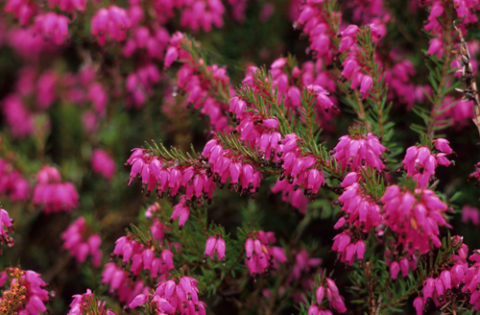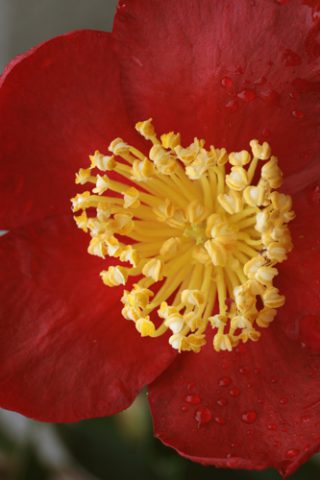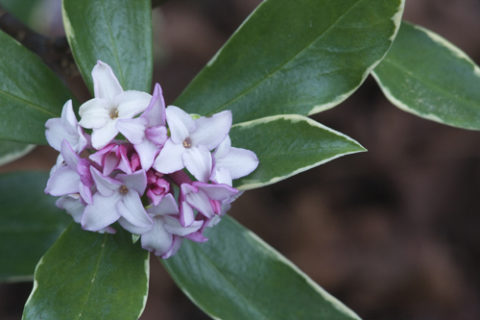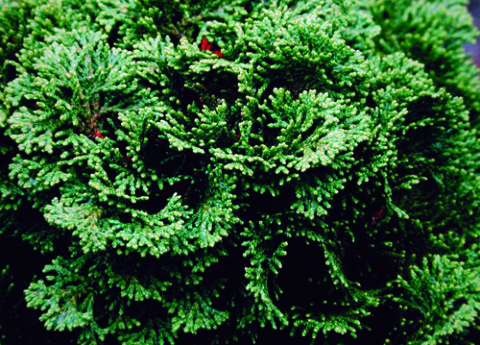
Sarcococca is an easy-care evergreen. It fills the air with a sweet scent on sunny winter days, living up to its common name, sweet box. This variety is Sarcococca confusa, Christmas box. Portland Nursery photo.
Would you like your landscape to look great year-round and be easier to care for, while helping our local environment? Plant more evergreens.
Evergreen plants, as their name suggests, stay green year round. Because their leaves or needles shade the soil, your garden beds will have fewer weeds.
This is especially important in winter, when the bare branches of deciduous trees and shrubs allow light to reach the soil. Many of our local weeds grow well in winter. Do you really want to spend rainy afternoons pulling weeds?
In addition, evergreen plants collect and slow down rain water. This reduces flooding and helps protect water quality.
According to Tilth Alliance, “Since evergreen plants do not go dormant in the winter, they can use up to 140 gallons of water a day. That’s a lot of water not overflowing our drainage systems.”
The leaves or needles of evergreens disperse rainfall into smaller droplets. This helps prevent erosion in the landscape. And they protect the ground from winter rains, resulting in less compaction of soil.
Choosing evergreen trees and shrubs
There are many great choices for evergreen trees and shrubs, both conifers and broad-leaf plants. Choices range from large trees to small, compact shrubs. Here are a few of our favorites.
Sarcococca
Right now Sarcococca, or sweet box (see photo above), is filling the air with a sweet fragrance. This glossy-leafed plant has small inconspicuous flowers, but its scent lives up to its name. The blossoms attract overwintering Anna’s hummingbirds, providing a food source in winter.
Portland Nursery lists a few different species and varieties. These lovely shrubs grow well in shade and are pest-free.

‘Porter’s Red’ winter heath (Erica carnea ‘Porter’s Red’) has hundreds of small, urn-shaped, magenta flowers from December or January until May. © Richie Steffen / Great Plant Picks.
Winter heaths and heathers
According to Great Plant Picks, “Winter heaths provide months of color just when we seems to need it most.” Most varieties have a low, spreading habit, making them excellent ground covers.
Winter heaths also benefit bees. Because bees are still active in colder months, they need winter-blooming flowers that provide pollen and nectar.
Heaths produce the most flowers in full sun. They prefer well-drained or sandy soil and need some water in dry periods. Heaths and heathers are fairly easy to grow in our climate and soil conditions.
Gardenia explains the difference between heaths and heathers and lists a number of varieties. And here is a list of recommended heaths and heathers from Great Plant Picks.

Camellia sasanqua ‘Yuletide’ blooms in December, livening up gray days. © Richie Steffen / Great Plant Picks.
Winter-blooming camellias
“Winter-blooming camellias liven up the winter garden,” said Ciscoe Morris in the Seattle Times. These shrubs have attractive flowers and glossy dark green foliage. Some varieties are fragrant.
Camellia sasanqua shrubs range from four to 12 feet tall and are easily pruned. The bloom season lasts for several months. They prefer well-drained soil and bloom best with morning sun.
As with sarcococca, camellia blossoms are magnets for Anna’s hummingbirds. They also attract bees.
Here are a few of Ciscoe’s favorite camellias.
Cisoe’s personal favorite is C.s. ‘Yuletide.’ It has fragrant, brilliant single red blossoms, centered with bright yellow stamens. It blooms from December to January. It grows to about five to seven feet tall and wide.
Camellia sasanqua ‘Fairy Blush’ grows to about five feet. It has deep pink buds that open to reveal dainty, sweetly scented single apple-blossom blooms. It is perfect for containers.
The darker pink flowering C.s. ‘Marge Miller’ has a natural weeping form, perfect for cascading over a wall.
Hybrid C. x ‘J.C. Williams’ is a vigorous grower that can reach eight feet tall and wide. It has beautiful single, soft pink flowers.

Variegated winter daphne, Daphne odora ‘Aureomarginata’, fills the air with sweet fragrance in March and April. © Richie Steffen / Great Plant Picks.
Daphne
Daphne is another sweet-smelling shrub. Daphne shrubs begin blooming in spring. Some varieties may bloom for as long as six months. While some daphnes are evergreen, others are only semi-evergreen, losing their leaves in cold snaps.
Daphnes may grow in sun or shade, depending on variety. While some varieties are easy to grow, others are fussy and may not survive severe weather.
In “The temptations of heartbreaker daphnes,” Rick Lupp at Mt. Tahoma Nursery, an expert daphne grower, tells the Seattle Times that good drainage is the key to survival. “This is because daphnes are extremely susceptible to fungal diseases which thrive in rich, damp dirt,” says Valerie Easton.
Here is a list of recommended daphnes from Great Plant Picks.

This dwarf Hinoki cypress, Chamaecyparis obtusa ‘Nana’, grows very slowly, rarely to more than two feet tall. © Richie Steffen / Great Plant Picks.
Hinoki cypress
Hinoki cypress are beautiful conifers that deserve a place in every garden. Plant at least one! You can choose from dwarf varieties that may only grow one to two feet tall or larger varieties that may grow to 15 feet.
These slow-growing trees do best in full sun. They adapt to a variety of soils. Once established, they are very drought-tolerant.
Here is a list of recommended Hinoki cypress from Great Plant Picks.
More choices for evergreens
Tilth Alliance recommends a number of evergreen plants that do well in an urban setting.
Trees
- Compact Strawberry Tree – Arbutus unedo ‘Compacta’ Lovely peeling bark as it ages, with white bell-shaped flowers in fall and red round fruits in summer, 6-8 ft tall, 5-6 ft wide.
- Hollywood Juniper – Juniperus chinensis ‘Kaizuka’ Unique upright, bold habit. 15 ft tall, 10 ft wide.
- Pacific Waxmyrtle – Myrica californica Upright and shrubby, this native can have an open, loose habit. Black fruits appear in fall. 10-30 ft tall over time.
- Tasmanian Leatherwood – Eucryphia glutinosa Large white flowers appear in summer, blooms for many weeks. Leaves take on tints of orange and red in the fall. The tree grows up to 25 feet, and can spread up to 15 feet wide. Grow in a spot sheltered from hot sun and wind.
- Tanyosho Pine – Pinus densiflora ‘Umbraculifera’ Showy cones, mounding shape and usually multi-trunks. Attracts birds. Slow growing to 15 ft.
- Tan Oak – Lithocarpus densiflorus Best in rich, moist soil, can be a tree or shrub, 10-20 ft high. The acorns are oak-like but the flowers are like those of chestnuts, provides wildlife food and nesting materials.
- Oregon Myrtle – Umbellularia califoranica Compact habit, Oregon myrtle looks great all year long. Provides wildlife food and shelter. Can reach 30 ft.
Shrubs
- Silk Tassel Bush – Garrya eliptica A very attractive broadleaf evergreen shrub, especially in winter when almost glowing, silky white tassels appear. Attracts beneficial insects, bees, and great for bird habitat and bird food.
- Coffeeberry – Rhamnus californica Red branches add interest and fruit ripens from green to red to black on this broadleaf evergreen shrub. Great for wildlife. Can reach 15 ft in 20 years.
- Evergreen Huckleberry – Vaccinium ovatum A native broadleaf evergreen plant; birds rely on the fruit in winter. Can reach 8 ft in shade, but will grow well and more compact in sun. Glossy, green leaves, red new growth and new stems; a very handsome plant.
- Mexican Orange – Choisya ternata Broadleaf evergreen with a large, round habit, can reach 6-8 ft tall and wide but can be pruned easily. Fragrant white flowers almost all year long if sited in full sun. Attracts bees.
- Camellia ‘Yuletide’ – Broadleaf evergreen, red flowers with yellow stamens, this camellia blooms late November. Good for hummingbirds, can reach 4-6 ft.
- Russian Olive – Elaeagnus angustifolia A nitrogen-fixing broadleaf evergreen shrub, good for breaking up clay soils.
- Spaan’s Dwarf Pine – Pinus contorta “Spaan’s Dwarf” Conifer shrub, may reach 3 ft and 4 ft wide in 10 years.
And even more choices
Tilth Alliance lists more evergreen trees and shrubs in “Plant a Garden for Winter Bouquets and Wreaths.”
Plant Oregon has a good list of broadleaf evergreens.
We can help
We would be happy to work with you to design and install a landscape that includes more evergreen trees and shrubs. Contact us about setting up a consultation with one of our talented landscape designers.
